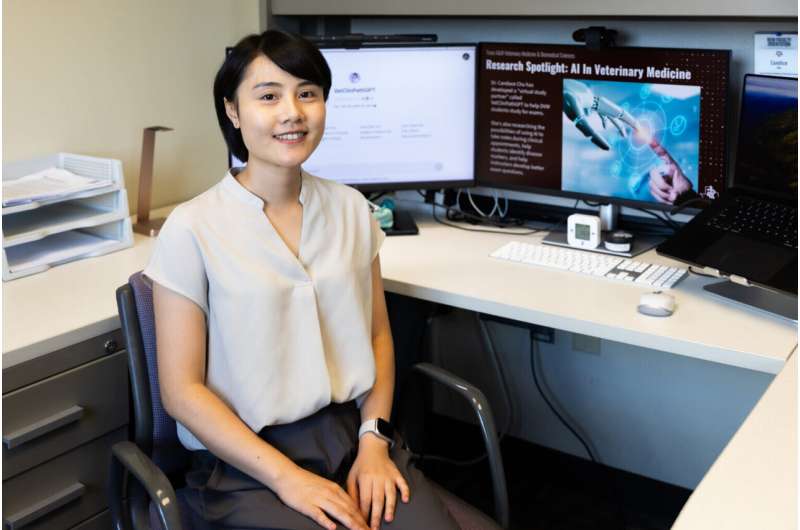This article has been reviewed according to Science X's editorial process and policies. Editors have highlighted the following attributes while ensuring the content's credibility:
fact-checked
trusted source
proofread
Exploring the benefits of AI in veterinary medicine and education

A researcher at the Texas A&M College of Veterinary Medicine and Biomedical Sciences (VMBS) is discovering new ways for veterinarians to use artificial intelligence (AI) tools in both the clinic and the classroom.
Dr. Candice Chu, an assistant professor in the VMBS Department of Veterinary Pathobiology, has developed a study tool for veterinary students based on ChatGPT technology called VetClinPathGPT.
The tool helps students in learning clinical pathobiology, a field of veterinary medicine that focuses on disease diagnosis, treatment and prevention. Using the tool, students can "chat" with AI to ask questions about terms and concepts or even ask the tool to provide a list of study questions.
Chu has also published a list of ways for AI to increase efficiency and expand the abilities of educators and clinicians in the journal Frontiers in Veterinary Science.
"AI is a powerful assistant that can help clinicians, educators and students reduce the time they spend on repetitive work," Chu said. "By reducing repetitive tasks, individuals can spend their time on the most important parts of their work, like completing assignments or helping students and patients."
Improving veterinary education with AI
Chu believes AI will become a regular part of the veterinary medicine classroom.
"Imagine having a microscope connected to a camera with AI capability, so students can look down at their slides and essentially have a clinical pathologist there to explain what they're seeing," Chu said. "They could ask the AI, 'What's that cell?' and it could tell them not only the type but also how to identify it.
"Veterinarians are in high demand and it's a good thing to have lots of students in the classroom," she said. "But one instructor cannot work with every student individually at the same time, so in my ideal world, AI would be able to help with that."
For now, Chu is helping to bring AI to veterinary education by creating tools like VetClinPathGPT that provide students with a virtual study partner.
"One of the best ways for students to use AI is to upload their course readings to an AI tool and ask it to make study questions based on the text," she said. "Once you read a passage, you can test your knowledge or use the AI to help you prepare for an exam."
Educators can also use AI to reduce the time they spend on repetitive tasks like writing exam questions.
"The key to getting high-quality, relevant answers to your prompts is to make sure that the information uploaded to the AI is reliable," Chu said. "For example, VetClinPathGPT doesn't use just any information from the internet—it uses the eClinPath website, an online textbook developed by the Cornell University College of Veterinary Medicine."
The future of veterinary medicine
Chu also expects to start seeing AI used in clinical settings to help with tasks that take away time from working with patients, like record-keeping.
"It would be very helpful to have a tool that could go through medical records and pull examples from cases," Chu said. "Imagine having a tool that could fill out medical records while you're talking with a patient's owner."
While the technology for such things exists, the problem is making sure that the AI tool doesn't compromise the privacy of medical records.
"Training AI tools to accurately read patient medical records would mean needing to share medical records with a developer, which violates patient privacy laws," Chu said. "The same is true for a clinician who wants to use AI to identify important information in a patient's file. If you have to spend a lot of time redacting all of the personal information, you're probably just going to go through the records yourself."
But in Chu's opinion, it's only a matter of time before someone creates AI tools that meet the needs of hospitals, clinicians and their patients.
"There are already ways to build a custom version of ChatGPT and make it private so no one else can use it," she said. "Another option is to have an AI tool that only exists locally on your computer or your clinic's network."
A partnership, not a takeover
From Chu's perspective, using AI will always be a partnership between human and artificial intelligence.
"Neither are perfect on their own, so bringing them together increases our ability to diagnose, teach and learn," she said. "One thing I tell people is not to worry that AI will replace you; it's the person who knows how to use AI who will replace you. I think that in the future, knowing how to incorporate this technology will be a basic requirement to be an efficient and competitive veterinary educator in the job market."
In addition to her work on study tools, Chu is also partnering with the VMBS Gastrointestinal Laboratory and the Texas A&M Institute of Data Science on a machine learning project to see if AI can help diagnose acute pancreatitis in dogs.
She's also been invited to give a keynote lecture at the American College of Veterinary Radiology Scientific Conference this fall, and will share her research on AI at two other fall conferences—the Texas Taiwanese Biotechnology Association Symposium and the American College of Veterinary Pathologists Annual Meeting.
"This technology is still very new, so there are many opportunities for innovation," she said.
More information: Candice P. Chu, ChatGPT in veterinary medicine: a practical guidance of generative artificial intelligence in clinics, education, and research, Frontiers in Veterinary Science (2024). DOI: 10.3389/fvets.2024.1395934. doi.org/10.3389/fvets.2024.1395934
Provided by Texas A&M University





















